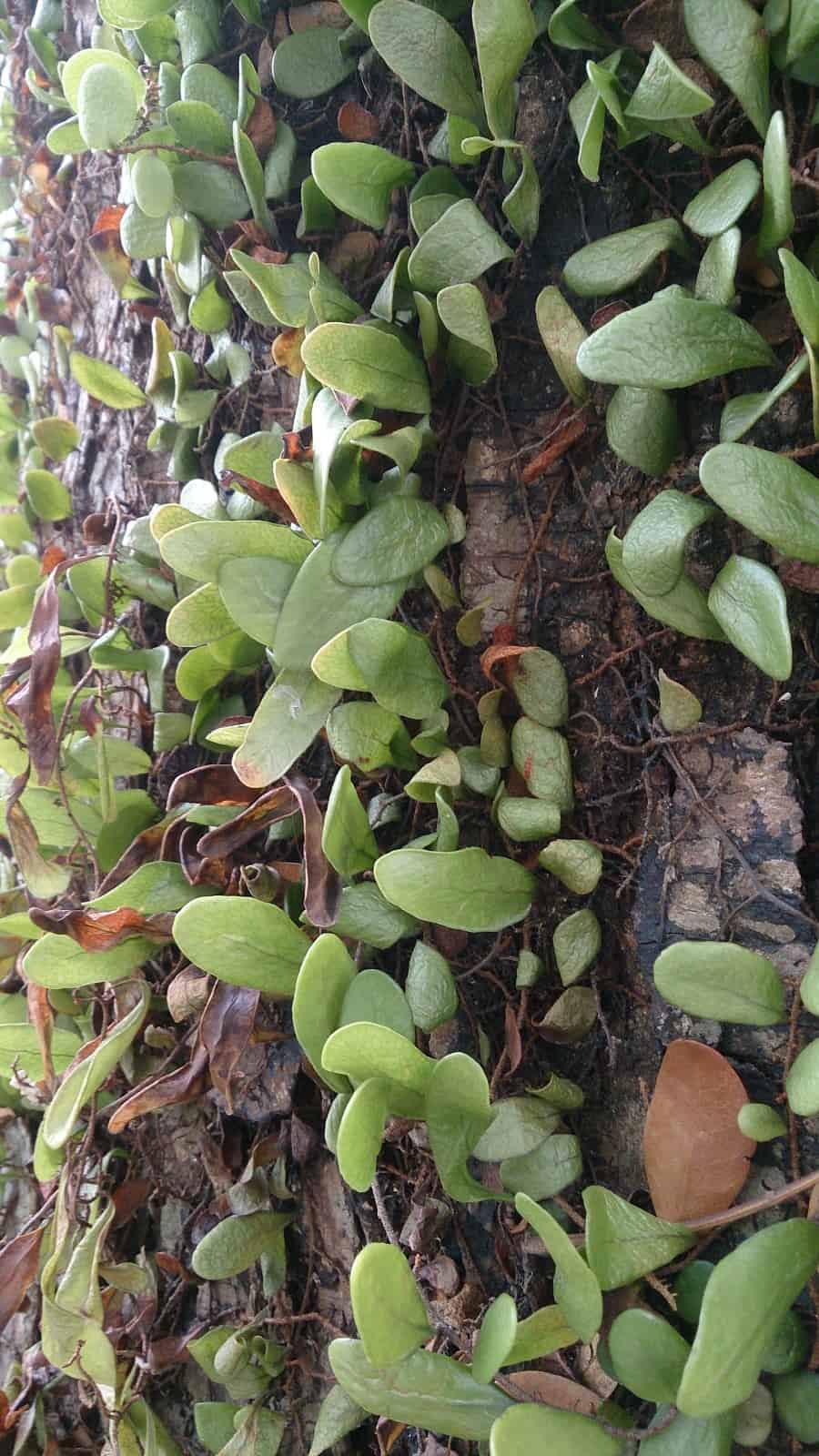One of the great benefits of Dischidia nummularia’String of Nickels’ is that it is an exuberant plant that needs little care.
As you know, succulent plants are very hardy and are also capable of storing their own water reserves.
This way, they become mostly self-sufficient plants that do not need our continuous intervention to survive.
This means that your Dischidia Nummularia will stay healthy and strong with little care as long as you guarantee optimal environmental conditions.
Dischidia Nummularia is a curious, slow-growing epiphytic plant related to the genus Hoya with fleshy rounded leaves on long hanging stems.
This succulent is a fabulous hanging plant with immense decorative value.
Its growth is slow, but it establishes clumps of long stems crowded with succulent foliage.
They produce bouquets of white, waxy flowers that are very interesting from an ornamental point of view.
They bloom in early summer. After flowering, we can collect the seeds that must be sown within a few days.
These succulents are mainly used as houseplants in hanging baskets or small pots.
You may like: Echeveria lilacina
Dischidia nummularia ‘String of Nickels’ Care:
Temperature:
Dischidia Nummularia is from hot climates; its ideal temperature will always be above 15ºC/59°F.
It does not tolerate low temperatures, so you will not be able to have it outside during winter.
This plant also needs ventilated and high humidity environments.
Illumination:
Dischidia Nummularia is a plant with many leaves, so in general, the more leaves a plant has, the more lighting it needs.
This means that for your plant to grow strong and at a good rate, it needs to receive a lot of indirect light.
Ideally, place the plant near a window where the sun’s rays filtered by a curtain.
It can be exposed directly to the sun, but it is preferable to avoid the central hours of the day because its leaves can burn.
How can you tell if your Dischidia is receiving the right amount of light? If you notice that the stems grow long, weak, and with a lot of separation between leaves, it needs to receive more light.
Watering:
This plant does not need much water. So when watering make sure not to overdo it.
Water it only when the substrate is dry and in small amounts.
Let the excess water drain if there is any.
Substrate:
The Dischidia nummularia is not very demanding with the soil nutrients, so the priority when choosing the substrate is that it offers good drainage.
Fertilizer:
Dischidia is a fairly slow-growing plant, so fertilizing will be very useful to accelerate its development.
Ideally, use a green plant fertilizer during spring and summer and let it rest in winter.
You can use a diluted fertilizer along with the water to ensure the nutrients in the compost reach the roots of the plant.
Diseases:
They are very resistant, but mealybugs, aphids (especially in flowers), and mollusks (snails and slugs) are enemies that must be monitored and controlled.
Propagation:
One way to multiply Dischidia is by cuttings or by dividing the stems.
Place the stems in water until roots come out, and after a few weeks when the roots are big, plant them in the same pot as the original plant.
Pruning:
This plant does not require pruning. You only need to remove the withered leaves, but if you want the plant to look much better, you can prune it as you please.
Transplant:
The act of transplanting itself is quite easy; fortunately, succulents and cacti are hardy plants you won’t have any issues.
At a minimum, you will need new soil and another pot to place the plant.
The new pot or container should also be slightly larger.
Depending on the plant, you may also want to wear some thorn-proof gardening gloves.
Handling cacti can be quite painful if you are not well prepared.
Hold the succulent or cactus firmly at the base of the stem as close to the ground as possible.
Make sure that you are holding the actual stem, not the leaves. Shake it lightly, moving it from side to side until it begins to loosen from the ground.
If there is no stem to grab onto, like in the case of an Echeveria, use a knife or trowel to loosen the dirt around the edges of the pot so you can get the whole thing out.
Remove the soil from the roots by rubbing it between your fingers.
You don’t need to remove every last grain of soil but remove as much as you can.
Use water to loosen the soil from the roots if necessary. It’s ok if some roots break, they will grow back.
Transplant the succulent into the new pot:
Fill the new pot about 1/3 of its depth with a new mix for cacti and succulents.
You can put a mesh or the typical piece of broken pot over the drain hole to prevent the soil from falling, but it is not necessary.
Place the succulent on top of the soil and then, while holding the plant in place, fill the pot with mixture 1 or 2 centimeters below the edge.
None of the stems of the plant must be below the ground, only roots.
Compact the soil slightly to keep it in place.
Add a decorative layer (optional) to finish the transplanting process; you can add a layer of pebbles to fill the pot.
Once your succulent is in a pot and the top substrate is in place, let it sit for a day or two before watering.
This rest period will give the roots time to heal before they begin to absorb the water, helping to prevent root rot.
As a general rule, you should avoid carrying out any transplanting in the winter months (since, in the event that any root is damaged, the cold and humidity can rot the plant).
The best time for succulent transplants is spring and summer, which are the plant’s growing seasons (not in all succulent species).
